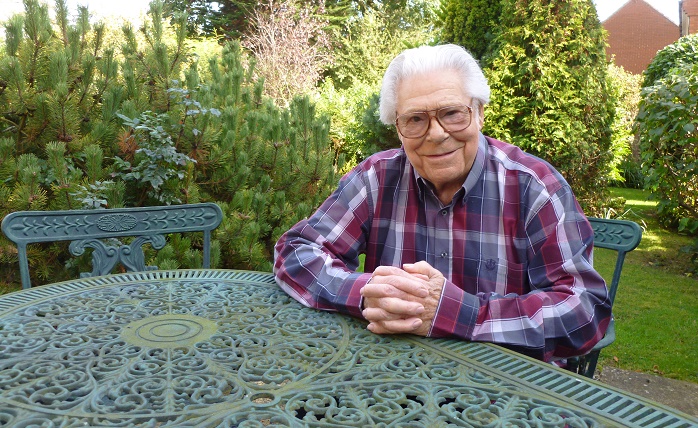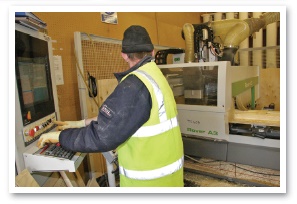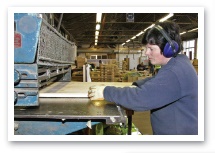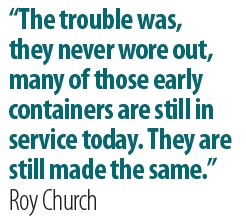If you are in the removals business, your life has been touched by Roy Church; you probably don’t know it, but it has, I assure you. Every now and then someone comes along who changes things, permanently. Roy is such a man. By Steve Jordan.

His claim to fame is as the joint owner of Trafalgar Cases, the UK’s leading supplier of warehouse containers. The company supplies, what has become, the Standard container on which all lorry design and warehouse layouts are based. But who set the Standard? That would be Roy and his cohorts.
Roy was born in Forrest Gate in London’s East End in 1927 (which makes him 87 now to save you doing the maths). He was the son of a fruit and veg wholesaler who supplied shops and markets throughout the city. From the age of seven Roy would help out bringing the produce from the farmers and selling it to the tradesmen in the London markets. He was an East End barrow boy, and he’s proud of it. When I asked him for an interview he said “Why me? There are plenty more interesting people than me to talk to.” I disagree.
 Roy went to work for Unilever when he was 15. “I didn’t want to follow my father,” he said. “I know it sounds daft but I couldn’t bear the way they used to spit on the floor and swear.” When he came out of the RAF at 21 Unilever put him on the packaging side. “I fell in love with it. I used to take boxes apart to see how they were made.” By this time Roy was a management trainee and Unilever would
Roy went to work for Unilever when he was 15. “I didn’t want to follow my father,” he said. “I know it sounds daft but I couldn’t bear the way they used to spit on the floor and swear.” When he came out of the RAF at 21 Unilever put him on the packaging side. “I fell in love with it. I used to take boxes apart to see how they were made.” By this time Roy was a management trainee and Unilever would  send him to see customers. One was industrial packaging company Sumacon Luralda Packaging. He told the customer that he was planning on being a manager by the time he was 40. “He said come and work for me and you’ll be a director by the time you’re 30, so I did.”
send him to see customers. One was industrial packaging company Sumacon Luralda Packaging. He told the customer that he was planning on being a manager by the time he was 40. “He said come and work for me and you’ll be a director by the time you’re 30, so I did.”
Sumacon Luralda operated under a holding company Armour Cases. The work was not exclusively household goods. Roy was involved in a wide range of packaging projects including security cases for transporting drugs; he perfected and patented the flat fold MFO box (Married Families Only) and sold them in their thousands to the UK forces; he  developed a special slim-line box for the spare parts for submarines all of which “had to go in through a hole in the top”; and designed a special shaped box to carry helicopter spares on the aircraft carrier HMS Invincible. There’s a gleam in his eye when he tells the story of being invited to dine with the captain in the officers’ mess. When the captain congratulated him on his achievement he said “not bad for a corporal in the RAF”. His fellow diners’ reactions are not recorded!
developed a special slim-line box for the spare parts for submarines all of which “had to go in through a hole in the top”; and designed a special shaped box to carry helicopter spares on the aircraft carrier HMS Invincible. There’s a gleam in his eye when he tells the story of being invited to dine with the captain in the officers’ mess. When the captain congratulated him on his achievement he said “not bad for a corporal in the RAF”. His fellow diners’ reactions are not recorded!
Also at Armour Cases at that time was its marketing manager, the infamous Fred Shea who many will remember from his advertising strap line ‘Ask Fred. Fred knows’. And Fred did know about warehouse cases. The first had been sold in 1962 to Brewer and TurnBull. Before then, goods were stored in the old-fashioned emporiums hidden under blankets as loose storage. White and Company (Sam Elliott and Geoff Halliwell) followed soon after. Pickfords too. But there was still no standardisation. They all had their own designs.
It was only when Roy and the team at Armour Cases started working intensively with George Taylor from Michael Gerson that the ultimate warehouse container, with optimised dimensions and the classic Anti-Luce fitting, emerged as the global standard. From that time on, vehicle design and warehouse dimensions would be dictated by the work those guys did. The containers started selling fast. Michael Gerson, Pickfords and Trans Euro (Stewart Peck) were the early adopters. Others followed. They were sold throughout Europe and beyond.
 In 1985 fate bowled Armour Cases ‘a bouncer’. The company was taken over by a big timber company that decided to move production from Kings Langley in Hertfordshire, to St. Ives, 40 miles away. Many of the company’s loyal case makers, ‘Roy’s Boys’ as he called them, were to lose their jobs. This Roy was not prepared to accept. He and his colleague John Crawley, with considerable help from the Royal Bank of Scotland, with four of ‘the boys’ set up on their own: Trafalgar Cases was born.
In 1985 fate bowled Armour Cases ‘a bouncer’. The company was taken over by a big timber company that decided to move production from Kings Langley in Hertfordshire, to St. Ives, 40 miles away. Many of the company’s loyal case makers, ‘Roy’s Boys’ as he called them, were to lose their jobs. This Roy was not prepared to accept. He and his colleague John Crawley, with considerable help from the Royal Bank of Scotland, with four of ‘the boys’ set up on their own: Trafalgar Cases was born.
“We found a small place in Watford,” said Roy. June (his wife) and John’s wife helped. “We lived on Cup-a-Soup for weeks and had a queue of ‘the boys’ wanting to join us. Within a year we were bursting. We were working on the pavement.” That year they found new premises in Kings Langley (close to where Armour had been), opened by Joe Luxford, the then BAR President. The company occupies the same factory today.
Gradually, the business increased. As the Standard warehouse container was adopted they were selling them as fast as they could be made. “I asked George Taylor for some guidance on the new business,” explained Roy. “George said he had three pieces of advice: ‘quality, quality, quality’. It was something I never forgot.” Trafalgar always built with quality in mind using the finest materials and the designs perfected through much experimentation with George Taylor. “The trouble was, they never wore out,” joked Roy. “Many of those early containers are still in service today. They are still made the same.”
Roy was 57 when he and John started. When he retired in 1998, on his 70th birthday, the company had a turnover of £6m and employed 80 people, including many of Roys Boys, Fred Shea and, of course, Mark Penticost, the Sales Director, who had been with Armour in St. Ives. “Mark worked really hard when he joined us,” said Roy. “He really deserves his success. It’s great to know that the company is in such safe hands.”
Armour went bust in about 1990. “I watched the bulldozer knock the place down. It’s now a housing estate,” said Roy.
 Roy is retired now of course. June sadly died in 2003. He lives alone in his home in St. Ives, with his beautiful garden, his memories and the regular and affectionate attentions of a small band of loyal friends that he calls his ‘little family’. They include: Jan and Tony Allen, Tony and Frances Richman, Sue Barrett, Shirley and Michael Gerson, David and Diane Trenchard, and Mike and Sylvia Lane. He remembers his days in ‘the business’ with fondness and is happy to recall days gone by including happy times at BAR conferences with June being whisked around the dance floor by David Trenchard, “I wasn’t much of a dancer,” and Tony Allen playing the piano. “It doesn’t seem to me that it’s quite the same now. Everybody is too busy to have time for each other.”
Roy is retired now of course. June sadly died in 2003. He lives alone in his home in St. Ives, with his beautiful garden, his memories and the regular and affectionate attentions of a small band of loyal friends that he calls his ‘little family’. They include: Jan and Tony Allen, Tony and Frances Richman, Sue Barrett, Shirley and Michael Gerson, David and Diane Trenchard, and Mike and Sylvia Lane. He remembers his days in ‘the business’ with fondness and is happy to recall days gone by including happy times at BAR conferences with June being whisked around the dance floor by David Trenchard, “I wasn’t much of a dancer,” and Tony Allen playing the piano. “It doesn’t seem to me that it’s quite the same now. Everybody is too busy to have time for each other.”
He’s 87 now and his health isn’t great. His mind is as sharp as ever though. You may not have known Roy, John, Fred and the team from the early days but they have touched your life. They changed the industry for the better. After our lifetimes’ work, will we be able to say the same?
Photos: Top: Roy in the garden of his home in St.Ives; Cases are still being made to Roy's original design at the Trafalgar Cases factory just outside Watford.
Click here to view the next Editor's pick.